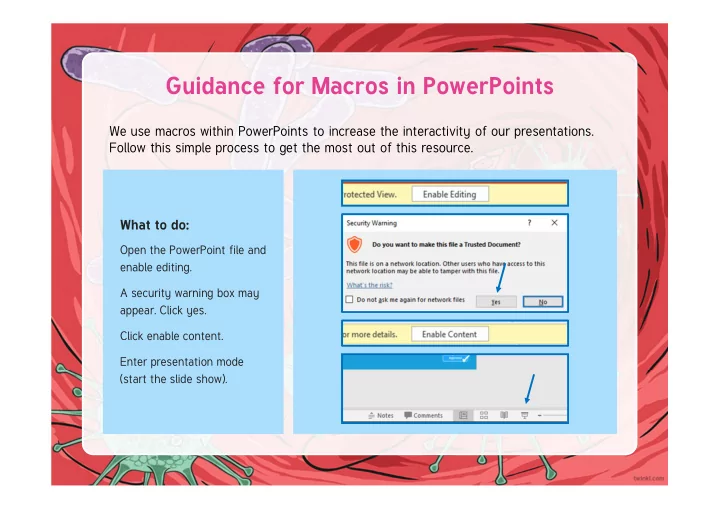

Guidance for Macros in PowerPoints We use macros within PowerPoints to increase the interactivity of our presentations. Follow this simple process to get the most out of this resource. What to do: Open the PowerPoint file and enable editing. A security warning box may appear. Click yes. Click enable content. Enter presentation mode (start the slide show).
Year One Science Scientists and Inventors Science | Year 6 | Scientists and Inventors | Alexander Fleming | Lesson 4
Aim • To record and interpret data on the effects of penicillin using a scatter graph. Success Criteria • I can describe Fleming’s discovery of penicillin. • I can construct a scatter graph from a table of results. • I can answer questions about the effects of penicillin using my scatter graph.
Treating Illnesses Some illnesses are caused by microorganisms. Click on the conditions below which you think are caused by microorganisms such as bacteria, fungi or viruses. If you are right, the box will change colour. Chicken pox Chicken pox Nose bleed Ear infection Ear infection Impetigo Impetigo Broken leg Tonsillitis Tonsillitis Athlete's foot Athlete's foot Salmonella Salmonella
Treating Illnesses There are different ways to treat illnesses caused by microorganisms. Some of the medicines kill or stop the growth of the bacteria or fungus that caused the illness, whereas other medicines just ease the symptoms of the illness. Click on the medicines that you think kill or stop the growth of microorganisms. Paracetamol Antiseptics Antiseptics Antibiotics Antibiotics Cough medicine
Alexander Fleming During the First World War, Fleming Alexander Fleming was a Scottish scientist who made an important breakthrough in the treatment of illnesses caused by bacteria. served as a captain in the Royal Army Medical Corps. He worked in battlefield hospitals on the Western Front in France He was born in 1881 and grew up in his family throughout the war. Fleming witnessed home in Scotland. the deaths of many soldiers from infected wounds. At the age of 20, Fleming began a medical degree at St Mary’s Hospital Medical School in After the war, his experiences led him Paddington, London. Fleming’s brother Tom to begin investigations to find an was also a doctor. antibacterial medicine that could treat infections.
Fleming's Discovery By 1928, Fleming had been investigating bacteria and antibacterials for several years. He had made some important discoveries, such as the discovery of lysozyme, an enzyme (chemical) in the human body that fights bacteria. Unfortunately, though his name had become well known, he had not found anything that could be used to fight bacteria on a large scale. This all changed in September 1928. Listen carefully to the story of his discovery and think about what you feel is the most important moment.
Fleming's Discovery Fleming had been on holiday with his family for the whole of August. He noticed that mould had grown in one of the Petri dishes. The colonies He was a brilliant scientist, but was known to be very untidy. He had of bacteria around the mould had been destroyed, whereas the bacteria not cleaned up his recent experiments with bacteria when he left for in other Petri dishes were still alive. his holiday. Fleming showed his discovery to his When he arrived back, he went to assistant, who agreed that it was his lab to sort through his old unusual. investigations. He began to tidy up some Petri dishes in which he had been growing bacteria.
Fleming's Discovery Fleming grew the mould in another Petri Two other scientists called Howard Florey dish and found that it killed several types and Ernst Boris Chain then built on of disease-causing bacteria. Fleming's discovery to mass-produce penicillin in order to treat the wounded soldiers of the Second World War. He originally called his discovery 'mould juice', but in March 1929 he officially named the substance ‘penicillin’. Fleming had discovered the world's first Fleming, Florey and Chain were awarded antibiotic that could be used to treat the Nobel Prize for their work in 1945. illnesses caused by bacteria.
Fleming Freeze Frame Which moment in the description of Fleming's discovery of penicillin did you think was most significant? Was it when he discovered the mould? Or when he realised that he had discovered an antibacterial fungus? Perhaps you think it was when he named his discovery penicillin, or when Florey and Chain produced penicillin for the soldiers of the Second World War. Decide which moment you and your partner think was most significant and why. Work together to create a tableau, or freeze frame, of your chosen moment.
Fleming Freeze Frame Your freeze frame should be a still picture of your chosen moment. You will communicate the significant moment through physical poses and your facial expressions. Show your freeze frames to the rest of the class. Can your classmates guess which moment you have chosen?
Effects of Penicillin Once you have constructed your graph, answer the questions about the Use the information on your Penicillin Effects Activity Sheet to create a scatter graph showing how penicillin affects the growth of bacteria. effects of penicillin on bacteria.
Antibiotic Resistance Penicillin has been used to treat illnesses caused by bacteria ever since Alexander Fleming first discovered it. However, some types of bacteria can become resistant to antibiotics like penicillin. This means the antibiotics no longer affect them. What are the potential implications of antibiotic resistance? What do scientists need to do to prepare for increased antibiotic resistance?
Aim • To record and interpret data on the effects of penicillin using a scatter graph. Success Criteria • I can describe Fleming’s discovery of penicillin. • I can construct a scatter graph from a table of results. • I can answer questions about the effects of penicillin using my scatter graph.
Recommend
More recommend